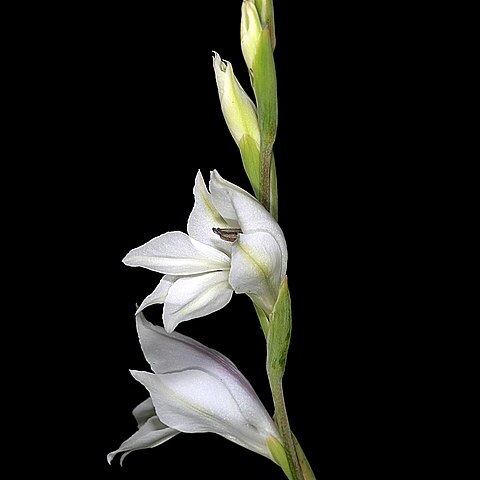Plants 200-450 mm high, often growing in small clumps. Corm globose, 18-25 mm diam., usually with 1 or 2 large cormlets at base; tunics of fine, densely matted fibres. Stem erect or inclined, simple or with 1 branch, usually flexed above sheath of uppermost leaf. Leaves 4 to 6, lower 2 to 4 basal, usually ± dry at flowering (or burned and absent), reaching or exceeding spike, somewhat fleshy, oval in section when fresh but with midrib area thickened and prominent when dry, 1.5-2.0 mm diam., cauline leaves entirely sheathing or with vestigial blades; new leaves emergent at flowering, produced from separate shoots, ultimately 3 or 4 basal leaves produced in summer. Spike inclined, lightly flexuose, 4-to 12-flowered; bracts green, sometimes flushed purple, outer 11-16 mm long, inner shorter, notched apically. Flowers white to cream-coloured usually flushed pink to dull purple on reverse toward tips and sometimes also on midline, evidently without markings, unscented; perianth tube narrowly funnel-shaped, 9-12 mm long, slender cylindric part 5-8 mm long; tepals oblanceolate, unequal, dorsal largest, 22-23 x 11-15 mm, hooded over stamens, upper laterals 15-20 x 7-8 mm, curving outward distally, lower 3 tepals joined to upper laterals for 2-4 mm and together for 2-3 mm, lower laterals 14-16 x 6-7 mm, lower median 10-12 x 7 mm. Filaments 10-12 mm long, exserted 6-9 mm from tube; anthers 5-6 mm long, purple; pollen cream-coloured. Style arching over stamens, dividing opposite upper 1/3 of anthers, branches ± 3.5 mm long. Capsules narrowly ovoid-ellipsoid, (10-)12-15 mm long. Seeds ovate, 6-7 x 3.5-4.5 mm, broadly and evenly winged.
More
Perennial herb, geophyte, 0.20-0.45 m high; corm globose, tunics of fine, densely matted fibres; stem erect or inclined, simple or 1-branched, flexed above. Leaves 4-6, fleshy, 1.5-2.0 mm wide; midrib thickened and prominent when dry. Bracts green, sometimes flushed purple above. Inflorescence a 4-12-flowered spike; flowers white to cream-coloured, the reverse of 3 upper tepals usually flushed pink to dull purple towards apex, no nectar guides; perianth tube narrowly funnel-shaped; tepals oblanceolate, unequal, the dorsal largest, hooded over stamens, upper laterals directed forward. Stamens exserted; anthers mauve; pollen cream-coloured. Ovary ovoid; style arching over stamens. Flowering time Oct.-Jan. Capsule narrowly ovoid-ellipsoid.

